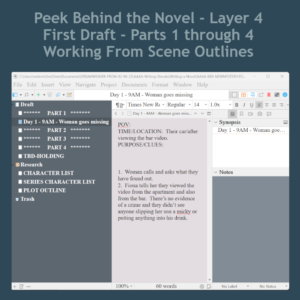Peek Behind the Novel – Writing the First Draft – Layer 4

 I usually decide to move a scene or two closer to the mid-section of the story. Because it’s only an outline, it’s easy-peasy.By seeing the scenes with the timings and a one to three word prompt, I start to see the story from above.I DON’T FORGET MY LANDMARKS – PART 1The Hook (Which we haven’t talked about yet)The crime scene or the acknowledgement of the mysteryThe Inciting Incident – When the detectives start off to solve the crime.By the end of Part 1, I want there to be at least 2 suspects or even 3.By the end of Part 1, more than one person looks guilty.LANDMARKS OF PART 2:Interviews begin – they point to different peopleClues begin to trickle in – they may seem to clear one or anotherOne of two secrets are exposed in Part 2.The end of Part 2 is the midway point. There could be a big surprise or shockLANDMARKS OF PART 3:More interviewsMore cluesEven the rise of another suspect, an unusual suspect.This rise of an unusual suspect can twist the story into another direction.This midway point could also be a Dark Night of the Soul where it may seem that the culprit may get away with it or it won’t be solved or solved in time.LANDMARKS OF PART 4:The first part of this section will be a big reveal.
I usually decide to move a scene or two closer to the mid-section of the story. Because it’s only an outline, it’s easy-peasy.By seeing the scenes with the timings and a one to three word prompt, I start to see the story from above.I DON’T FORGET MY LANDMARKS – PART 1The Hook (Which we haven’t talked about yet)The crime scene or the acknowledgement of the mysteryThe Inciting Incident – When the detectives start off to solve the crime.By the end of Part 1, I want there to be at least 2 suspects or even 3.By the end of Part 1, more than one person looks guilty.LANDMARKS OF PART 2:Interviews begin – they point to different peopleClues begin to trickle in – they may seem to clear one or anotherOne of two secrets are exposed in Part 2.The end of Part 2 is the midway point. There could be a big surprise or shockLANDMARKS OF PART 3:More interviewsMore cluesEven the rise of another suspect, an unusual suspect.This rise of an unusual suspect can twist the story into another direction.This midway point could also be a Dark Night of the Soul where it may seem that the culprit may get away with it or it won’t be solved or solved in time.LANDMARKS OF PART 4:The first part of this section will be a big reveal. The crime will be solved between the start of Part 4 up to 2/3 of the part.There needs to be time to wrap up the crime and show how it affects everyone involved.The last part of the story is for the ‘wrap up’ where you tie up all the loose ends.ABOUT WRITING THE WRAP UP:Reveal the guilty party and solve the mystery.Reveal why the red herring couldn’t be guilty.Do a quick review of the whole crime to confirm for the readersShow a ‘new normal’ for the main characters, showing their character arcs completing.In a series, you need to drop a clue that this crime is finished but their story continues.TIPS ON WRITING A FIRST DRAFT:Write forward only. Don’t look back.Don’t worry about spelling, grammar, verb tense, too many over-used words.The goal of the first draft is to get it down on paper and make sure you put everything into the story from your scene outlines.Think of it as ‘blurting out the story’.I’LL BE BUSY OVER THE NEXT FEW WEEKS WRITING:I’ve reached Layer 4 in my present novel. This layer takes time to get it all down on paper.By not worrying about prose or grammar, I’m free to just be creative about the story and whatever dialogue pops into my head.The first draft will be just that — a first draft.Rest assured that the first draft is important, but by the time I get all the way to Layer 8, it will be polished and not look anything like it looks in the first draft.I HOPE THIS SPURS SHARINGI hope my revelations of my writing techniques will prompt other authors to reveal their process.I love to learn new techniques and when I was brand new, learning from experienced authors was so very helpful.Be sure to sign up at ReadFirstChapter.com to get on my mailing list. I send book promotions once a week and notices of new books and notices of when my books go “free” on Amazon.
The crime will be solved between the start of Part 4 up to 2/3 of the part.There needs to be time to wrap up the crime and show how it affects everyone involved.The last part of the story is for the ‘wrap up’ where you tie up all the loose ends.ABOUT WRITING THE WRAP UP:Reveal the guilty party and solve the mystery.Reveal why the red herring couldn’t be guilty.Do a quick review of the whole crime to confirm for the readersShow a ‘new normal’ for the main characters, showing their character arcs completing.In a series, you need to drop a clue that this crime is finished but their story continues.TIPS ON WRITING A FIRST DRAFT:Write forward only. Don’t look back.Don’t worry about spelling, grammar, verb tense, too many over-used words.The goal of the first draft is to get it down on paper and make sure you put everything into the story from your scene outlines.Think of it as ‘blurting out the story’.I’LL BE BUSY OVER THE NEXT FEW WEEKS WRITING:I’ve reached Layer 4 in my present novel. This layer takes time to get it all down on paper.By not worrying about prose or grammar, I’m free to just be creative about the story and whatever dialogue pops into my head.The first draft will be just that — a first draft.Rest assured that the first draft is important, but by the time I get all the way to Layer 8, it will be polished and not look anything like it looks in the first draft.I HOPE THIS SPURS SHARINGI hope my revelations of my writing techniques will prompt other authors to reveal their process.I love to learn new techniques and when I was brand new, learning from experienced authors was so very helpful.Be sure to sign up at ReadFirstChapter.com to get on my mailing list. I send book promotions once a week and notices of new books and notices of when my books go “free” on Amazon.Here is the YouTube video that goes along with this blog post. I have the timestamps below in case you want to watch a certain part over or just skip to the relevant part.
00:01 – How I set up Scrivener into the Four Part Story Structure 01:15 – This process gives you a bird’s eye view of the entire story
02:00 – Showing in Scrivener how I set up the Binder, the documents, the Title and Synopsis sections and how I can use the Outline view to see a bird’s eye view of the entire manuscript as it comes together.
03:00 – Tracking case time and personal time in order to weave in the subplots
03:36 – How I use the screen outlines, moving the scene outline into the Notes section to keep it safe
04:25 – The Corkboard vs. Outline View 06:10 – Keeping the writing landmarks of Part 1 in mind: The hook, inciting incident, etc.
07:15 – Landmarks of Part 2, how the evidence trickles in – middle of the book
08:20 – Landmarks of Part 3 – Names the suspects and a dark night of the soul.
09:20 – First half of Part 4 – The big reveal and the wrap up of the mystery. 11:03 – Tying up all loose ends and the subplots. Showing the new normal. Ending the character arcs for this story.
12:00 – Writing series and letting the reader know the crime has been solved but their personal lives continue.
12:37 – Five tips to Beginner Writers 13:30 – The story crafter vs. the story author.



